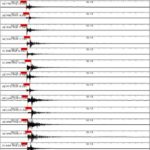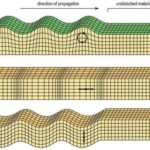| Magnitude | Earthquake Effects | Estimated Number Each Year |
| 2.5 or less | Usually not felt, but can be recorded by seismograph. | 900,000 |
| 2.5 to 5.4 | Often felt, but only causes minor damage. | 30,000 |
| 5.5 to 6.0 | Slight damage to buildings and other structures. | 500 |
| 6.1 to 6.9 | May cause a lot of damage in very populated areas. | 100 |
| 7.0 to 7.9 | Major earthquake. Serious damage. | 20 |
| 8.0 or greater | Great earthquake. Can totally destroy communities near the epicenter. | One every 5 to 10 years |
The Richter magnitude scale (also Richter scale) assigns a magnitude number to quantify the energy released by an earthquake. The Richter scale, developed in the 1930s, is a base-10 logarithmic scale, which defines magnitude as the logarithm of the ratio of the amplitude of the seismic waves to an arbitrary, minor amplitude.
As measured with a seismometer, an earthquake that registers 5.0 on the Richter scale has a shaking amplitude 10 times that of an earthquake that registered 4.0, and thus corresponds to a release of energy 31.6 times that released by the lesser earthquake.The Richter scale was succeeded in the 1970s by the moment magnitude scale. This is now the scale used by the United States Geological Survey to estimate magnitudes for all modern large earthquakes.
The following table lists the approximate energy equivalents in terms of TNT explosive force – though note that the earthquake energy is released underground rather than overground.Most energy from an earthquake is not transmitted to and through the surface; instead, it dissipates into the crust and other subsurface structures. In contrast, a small atomic bomb blast (see nuclear weapon yield) will not, it will simply cause light shaking of indoor items, since its energy is released above ground.
| Approximate magnitude | Approximate TNT equivalent for seismic energy yield |
Joule equivalent | Example |
|---|---|---|---|
| 0.0 | 15 g | 63 kJ | |
| 0.2 | 30 g | 130 kJ | Large hand grenade |
| 1.5 | 2.7 kg | 11 MJ | Seismic impact of typical small construction blast |
| 2.1 | 21 kg | 89 MJ | West fertilizer plant explosion |
| 3.0 | 480 kg | 2.0 GJ | Oklahoma City bombing, 1995 |
| 3.5 | 2.7 metric tons | 11 GJ | PEPCON fuel plant explosion, Henderson, Nevada, 1988 |
| 3.87 | 9.5 metric tons | 40 GJ | Explosion at Chernobyl nuclear power plant, 1986 |
| 3.91 | 11 metric tons | 46 GJ | Massive Ordnance Air Blast bomb |
| 6.0 | 15 kilotons | 63 TJ | Approximate yield of the Little Boy atomic bomb dropped on Hiroshima (~16 kt) |
| 7.9 | 10.7 megatons | 45 PJ | Tunguska event |
| 8.35 | 50 megatons | 210 PJ | Tsar Bomba—Largest thermonuclear weapon ever tested. Most of the energy was dissipated in the atmosphere. The seismic shock was estimated at 5.0–5.2 |
| 9.15 | 800 megatons | 3.3 EJ | Toba eruption 75,000 years ago; among the largest known volcanic events. |
| 13.0 | 100 teratons | 420 ZJ | Yucatán Peninsula impact (creating Chicxulub crater) 65 ago (108 megatons; over 4×1029 ergs = 400 ZJ). |
Source: Wikipedia
Determining the Depth of an Earthquake
Earthquakes can occur anywhere between the Earth’s surface and about 700 kilometers below the surface. For scientific purposes, this earthquake depth range of 0 – 700 km is divided into three zones: shallow, intermediate, and deep.
Shallow earthquakes are between 0 and 70 km deep; intermediate earthquakes, 70 – 300 km deep; and deep earthquakes, 300 – 700 km deep. In general, the term “deep-focus earthquakes” is applied to earthquakes deeper than 70 km. All earthquakes deeper than 70 km are localized within great slabs of shallow lithosphere that are sinking into the Earth’s mantle.
The evidence for deep-focus earthquakes was discovered in 1922 by H.H. Turner of Oxford, England. Previously, all earthquakes were considered to have shallow focal depths. The existence of deep-focus earthquakes was confirmed in 1931 from studies of the seismograms of several earthquakes, which in turn led to the construction of travel-time curves for intermediate and deep earthquakes.
The most obvious indication on a seismogram that a large earthquake has a deep focus is the small amplitude, or height, of the recorded surface waves and the uncomplicated character of the P and S waves. Although the surface-wave pattern does generally indicate that an earthquake is either shallow or may have some depth, the most accurate method of determining the focal depth of an earthquake is to read a depth phase recorded on the seismogram. The most characteristic depth phase is pP. This is the P wave that is reflected from the surface of the Earth at a point relatively near the epicenter. At distant seismograph stations, the pP follows the P wave by a time interval that changes slowly with distance but rapidly with depth. This time interval, pP-P (pP minus P), is used to compute depth-of-focus tables. Using the time difference of pP-P as read from the seismogram and the distance between the epicenter and the seismograph station, the depth of the earthquake can be determined from published travel-time curves or depth tables.
Another seismic wave used to determine focal depth is the sP phase – an S wave reflected as a P wave from the Earth’s surface at a point near the epicenter. This wave is recorded after the pP by about one-half of the pP-P time interval. The depth of an earthquake can be determined from the sP phase in the same manner as the pP phase by using the appropriate travel-time curves or depth tables for sP.
If the pP and sP waves can be identified on the seismogram, an accurate focal depth can be determined.





